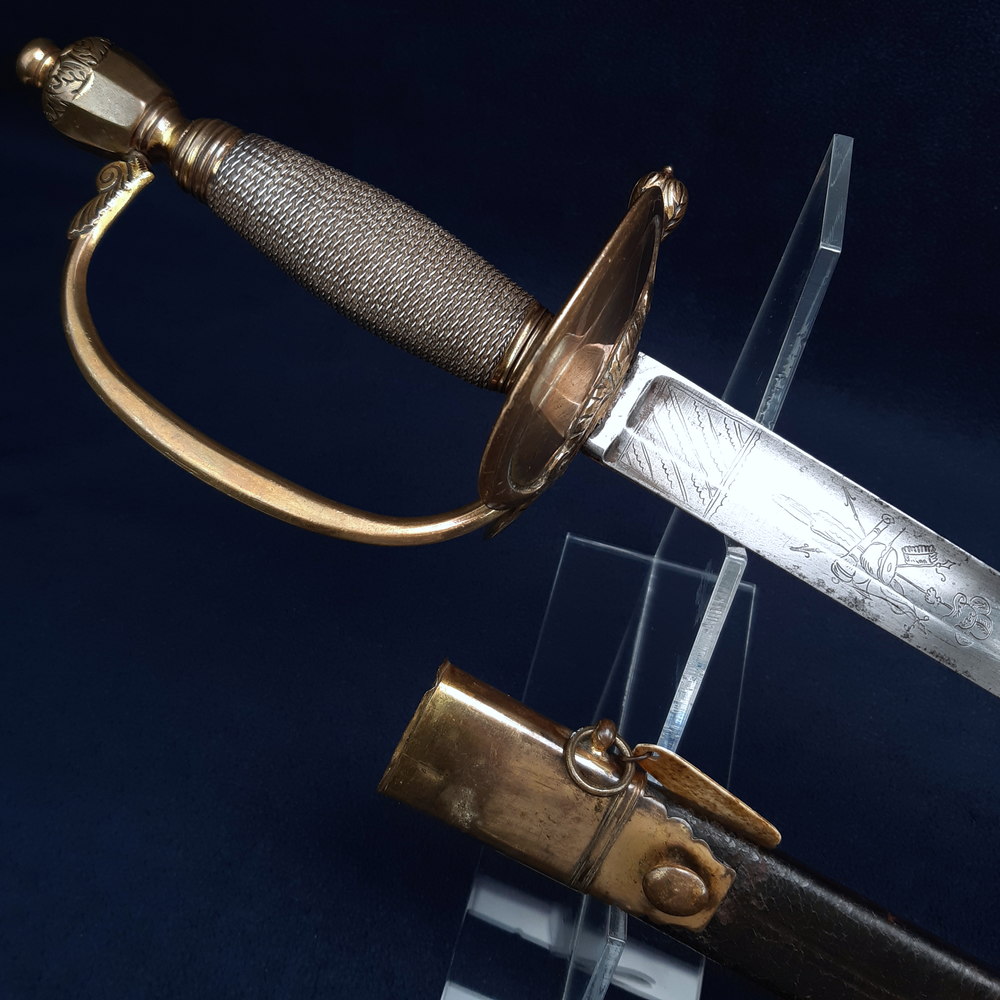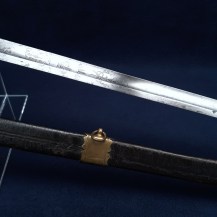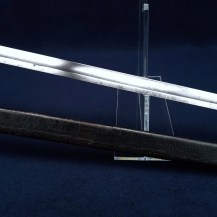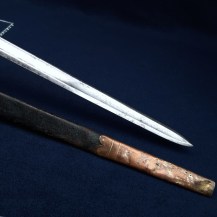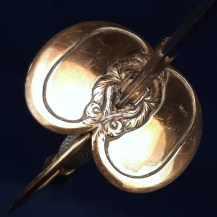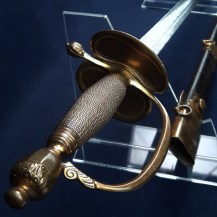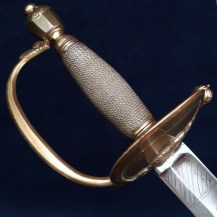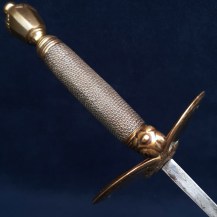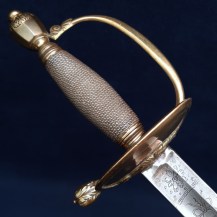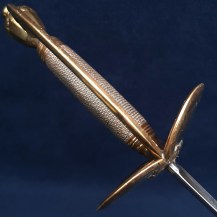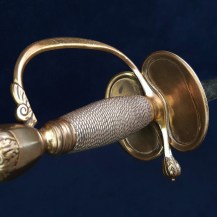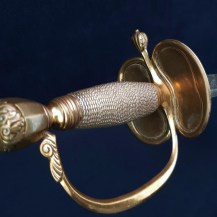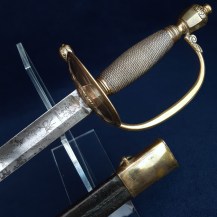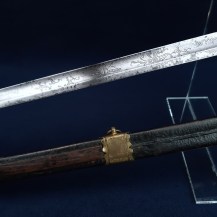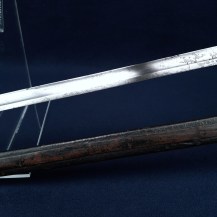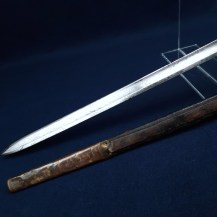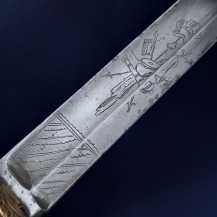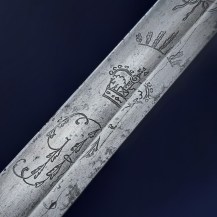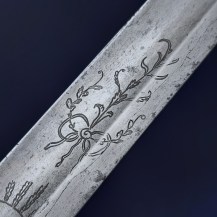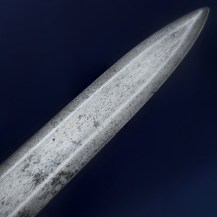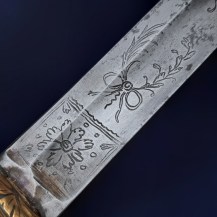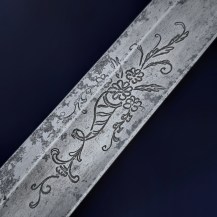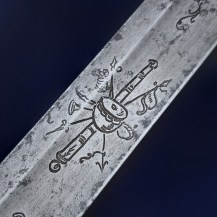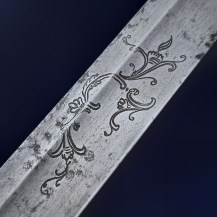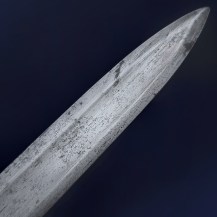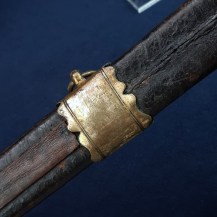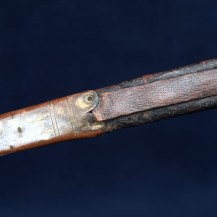British 1796 Pattern Infantry Officer’s Spadroon
Straight single fullered blade with false edge, short ricasso, the fuller extending the full length of the blade up to the tip. Smallsword hilt with all its parts in brass including fixed double shell guard, grip bound with silver wire, ribbed ferrules at each end of the grip, brass quillon in the form of a leaf rosette, slender brass knucklebow, faceted brass pommel. Black leather scabbard with brass throat & middle pieces, chape piece possibly of copper, the throat and middle pieces with brass hanging rings, the throat piece also with a frog stud, enabling the sword to be carried either in a frog or hanging at the trail. Blade 32 inches in length, 1.1 inches wide at the ricasso, the sword 38½ inches overall.
The blade is engraved with stands of arms, the crown and cypher of George III, sprigs of foliage, a wreath of laurel & palm, and a cornucopia. Decorative leaf edging to the hilt at the base of the blade, similar to the pommel.
The spadroon appears to have been an English innovation, first appearing around 1680. It was a light straight-bladed double-edged sword with a fuller typically running the entire length of the blade, which aimed to find a midpoint between the smallsword and broadsword, with a simpler, less restrictive guard compared to the elaborate mortuary and basket hilts of its predecessors. It was sometimes referred to as the ‘shearing’ sword and was regarded as a refined weapon, fast and agile due to its lightness but capable of cutting as well as thrusting.
The first formal instructions from the War Office on what swords should be carried by infantry officers was given in April 1786, specifying that swords should have straight cut-and-thrust blades, 32 inches long and at least 1 inch wide at the shoulder. The hilt, it said, should be of steel, or if not steel, should be gilt or silver according to the colour of the uniform buttons for that unit. These extremely vague rules resulted in a great deal of variation in the swords produced.
In 1796 the specification was updated, keeping the same blade but with a standardized double shell guard and wire-bound grip, which produced the 1796 Pattern. There was still some level of variation but this was usually restricted to decoration and extras, like the folding guard seen on some examples. This example is relatively simple, with only line engravings rather than the flashy blue & gilt blades seen on some examples, and a fixed hilt. This pattern was carried until the increasing popularity of sabres as fighting swords displaced the spadroon, leading to the radically different 1803 Pattern infantry officer’s sword.
The blade is sharp towards the tip, including the false edge, with no edge damage. The blade has some spots of patination, a couple of small spots of light pitting and some hairline forging imperfections. The engraved decoration is very clear. The brass parts of the hilt are lustrous with a moderate patina, some gilding remaining in the recesses. The wire binding of the grip is all intact with no losses and very light handling wear. Some movement to the shell guard and slight movement to the knucklebow & quillon.
The throat and middle pieces of the scabbard have some spots of patination, a few dents and some scratches to the middle piece on one side. The chape piece as mentioned appears to be gilt copper rather than brass – this is probably period, it is darkly patinated and like the other scabbard pieces retains small areas of gilding. It has a number of small dents, none of which interfere with sheathing and drawing. Small letters reading, as best I can make out, ‘DMSM’ have been crudely engraved on one side of the chape piece, this does not look period and I am not sure of its significance.
The scabbard leather has some surface-level cracking and small areas of flaking but is generally quite strong – on the reverse side a reinforcing strip of leather has been applied (probably glued) along the seam from the middle to the chape piece. This later repair was probably done to support the integrity of the scabbard after a loss of stitching to that section – a little of the stitching has also been lost between the middle and throat pieces. The short shoulder section remains visible when the sword is fully sheathed – this is probably due to the lack of a washer to fill the space between the hilt and the throat piece. Care should be taken to support the scabbard once the sword is withdrawn.
A hard plastic collection tag has been attached by a steel ring to the upper hanging ring by a previous owner. There is writing on this tag but it has both faded and stained making it very difficult to read – the first line I think reads ‘Capt J. Robertson’.

